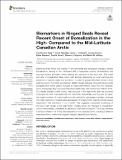Files in this item
Biomarkers in ringed seals reveal recent onset of borealization in the high- compared to the mid-latitude Canadian Arctic
Item metadata
| dc.contributor.author | de la Vega, Camille | |
| dc.contributor.author | Mahaffey, Claire | |
| dc.contributor.author | Yurkowski, David J. | |
| dc.contributor.author | Norman, Louisa | |
| dc.contributor.author | Simpson, Elysia | |
| dc.contributor.author | Smout, Sophie | |
| dc.contributor.author | Ferguson, Steven H. | |
| dc.contributor.author | Jeffreys, Rachel M. | |
| dc.date.accessioned | 2021-10-01T15:30:10Z | |
| dc.date.available | 2021-10-01T15:30:10Z | |
| dc.date.issued | 2021-09-07 | |
| dc.identifier | 276115773 | |
| dc.identifier | 8534af23-b093-4eae-9174-0c3032369181 | |
| dc.identifier | 000697317700001 | |
| dc.identifier | 85115401335 | |
| dc.identifier.citation | de la Vega , C , Mahaffey , C , Yurkowski , D J , Norman , L , Simpson , E , Smout , S , Ferguson , S H & Jeffreys , R M 2021 , ' Biomarkers in ringed seals reveal recent onset of borealization in the high- compared to the mid-latitude Canadian Arctic ' , Frontiers in Marine Science , vol. 8 , 700687 . https://doi.org/10.3389/fmars.2021.700687 | en |
| dc.identifier.issn | 2296-7745 | |
| dc.identifier.other | RIS: urn:FFE4968795AFB3AB93E76BBB4EB021E8 | |
| dc.identifier.uri | https://hdl.handle.net/10023/24073 | |
| dc.description | This work resulted from the ARISE project (NE/P006035/1), part of the Changing Arctic Ocean program, funded by the UKRI Natural Environment Research Council (NERC). | en |
| dc.description.abstract | Warming of the Arctic has resulted in environmental and ecological changes, termed borealization, leading to the northward shift of temperate species. Borealization has occurred across all trophic levels, altering the structure of the food web. The onset and rate of borealization likely varies with latitude, depending on local warming and advection of warmer water into the Arctic. In order to assess latitudinal trends in food web structure in the Arctic, we analyzed stable nitrogen isotopes of specific amino acids alongside bulk stable carbon isotopes in ringed seal muscle tissue from the Canadian Arctic Archipelago (high-Arctic) and Southern Baffin Bay (mid-Arctic) from 1990 to 2016. Our results indicate a shift in food web structure in the high-Arctic that has occurred more recently when compared with the mid-Arctic. Specifically, over the past 25 years, the trophic position of ringed seals from the mid-Arctic was largely constant, whereas the trophic position of ringed seals decreased in the high-Arctic, reaching similar values observed in the mid-Arctic in 2015-2016. This suggests a potential shortening of the food chain length in the high-Arctic, possibly driven by changes in zooplankton communities feeding complexity in association with sea ice decline. This study identifies a temporal offset in the timing of borealization in the Canadian Arctic, resulting in different response of food webs to ecological changes, depending on latitude. | |
| dc.format.extent | 11 | |
| dc.format.extent | 1723549 | |
| dc.language.iso | eng | |
| dc.relation.ispartof | Frontiers in Marine Science | en |
| dc.subject | Trophic position | en |
| dc.subject | Food web structure | en |
| dc.subject | Borealization | en |
| dc.subject | Canadian Arctic | en |
| dc.subject | Ringed seals | en |
| dc.subject | Stable isotopes | en |
| dc.subject | Amino acids | en |
| dc.subject | Latitudes | en |
| dc.subject | GE Environmental Sciences | en |
| dc.subject | QH301 Biology | en |
| dc.subject | DAS | en |
| dc.subject.lcc | GE | en |
| dc.subject.lcc | QH301 | en |
| dc.title | Biomarkers in ringed seals reveal recent onset of borealization in the high- compared to the mid-latitude Canadian Arctic | en |
| dc.type | Journal article | en |
| dc.contributor.institution | University of St Andrews. Coastal Resources Management Group | en |
| dc.contributor.institution | University of St Andrews. School of Biology | en |
| dc.contributor.institution | University of St Andrews. Sea Mammal Research Unit | en |
| dc.contributor.institution | University of St Andrews. Scottish Oceans Institute | en |
| dc.contributor.institution | University of St Andrews. Centre for Research into Ecological & Environmental Modelling | en |
| dc.identifier.doi | https://doi.org/10.3389/fmars.2021.700687 | |
| dc.description.status | Peer reviewed | en |
This item appears in the following Collection(s)
Items in the St Andrews Research Repository are protected by copyright, with all rights reserved, unless otherwise indicated.

